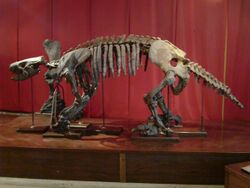Biology:Scelidodon
| Scelidodon | |
|---|---|

| |
| Scientific classification | |
| Script error: No such module "Taxobox ranks".: | Animalia |
| Script error: No such module "Taxobox ranks".: | Chordata |
| Script error: No such module "Taxobox ranks".: | Mammalia |
| Script error: No such module "Taxobox ranks".: | Pilosa |
| Script error: No such module "Taxobox ranks".: | †Scelidotheriidae |
| Script error: No such module "Taxobox ranks".: | †Scelidodon Ameghino, 1881 |
| Type species | |
| †Scelidodon copei Ameghino, 1881
| |
| Other species | |
| |
| Synonyms | |
| |
Scelidodon is an extinct genus of South American ground sloths. Its remains have been found in the Yupoí and Uspara Formations of Argentina , the Ulloma, Umala, Ñuapua and Tarija Formations of Bolivia, in Brazil , in Chile and in Peru.[1] The youngest fossils have been dated to as recently as 9000 B.P.[2]

Description
Scelidodon was one of the last of the ground sloths and was one of the largest scelidotheriids, with S. chiliense reaching up to 4.7 meters.[3] Its body weight has been estimated at over 1500 kg.[4] Scelidodon was widely distributed in temperate grassland environments and due to its contemporary megatheriines being high browsers, this suggests that Scelidodon was a grazer[5] like its close relative, Scelidotherium.[6]
Discovery
The first remains of Scelidodon were collected in the 1850s in Tarija Valley, Bolivia and consisted of a skull and mandible (MNHN TAR 1260).[3] It wasn't until 1880 that Paul Gervais and Florentino Ameghino described the remains as Scelidotherium tarijarensis[3]. In the same paper, Scelidotherium capellini was described based on a left hemimandible (MNHN PAM 231) with a referred skull (MACN 994), the fossils were found at ‘‘Toscas del Rio de la Plata’’ in Argentina . The genus Scelidodon was erected in 1881 with the type species, Scelidodon copei, name by Ameghino.[3] The type specimen (MACN A-1158) of S. copei comes from Ensenadan sediments in Mercedes, Buenos Aires province and consists of a left maxilla.[3] S. tarijarensis and S. capellini were transferred to Scelidodon in 1889 by Ameghino.[3] S. chiliense was named based on a skull (BMNH M 2819) from the late Pleistocene of Chile by Richard Lydekker in 1886. Since the 19th century, much material of Scelidodon has been found from 5 countries and is one of the most well preserved scelidotheres.[3][6]
References
- ↑ Scelidodon at Fossilworks.org
- ↑ Turvey, Sam (2009). Holocene extinctions. Oxford University Press. pp. 20–33, 42–50, 352. ISBN 978-0-19-953509-5. https://books.google.com/books?id=mbU-F42JU1AC&pg=PA24.
- ↑ 3.0 3.1 3.2 3.3 3.4 3.5 3.6 Miño-Boilini, Á. R., & Carlini, A. A. (2009). The Scelidotheriinae Ameghino, 1904 (Phyllophaga, Xenarthra) from the Ensenadan–Lujanian Stage/Ages (Early Pleistocene to Early-Middle Pleistocene–Early Holocene) of Argentina. Quaternary International, 210(1-2), 93–101.
- ↑ Toledo, N.; Bargo, M. S.; Vizcaíno, S. F.; De Iuliis, G.; Pujos, F. (2017). "Evolution of body size in anteaters and sloths (Xenarthra, Pilosa): phylogeny, metabolism, diet and substrate preferences". Earth and Environmental Science Transactions of the Royal Society of Edinburgh 106 (4): 289–301. doi:10.1017/S1755691016000177.
- ↑ Miño-Boilini, A. R., Carlini, A. A., Chiesa, J. O., Lucero, N. P., & Zurita, A. E. (2009). First record of Scelidodon chiliense (Lydekker)(Phyllophaga, Scelidotheriinae) from the Lujanian stage (late Pleistocene-early Holocene) of Argentina.[|permanent dead link|dead link}}] Neues Jahrbuch für Geologie und Paläontologie-Abhandlungen, 253, 373–381.
- ↑ 6.0 6.1 Guérin, Claude; Faure, Martine (January 2004). "Scelidodon piauiense nov. sp., nouveau Mylodontidae Scelidotheriinae (Mammalia, Xenarthra) du Quaternaire de la région du parc national Serra da Capivara (Piauí, Brésil)" (in fr). Comptes Rendus Palevol 3 (1): 35–42. doi:10.1016/j.crpv.2003.10.007. Bibcode: 2004CRPal...3...35G. https://linkinghub.elsevier.com/retrieve/pii/S1631068303001581.
Wikidata ☰ Q7430691 entry
 |
